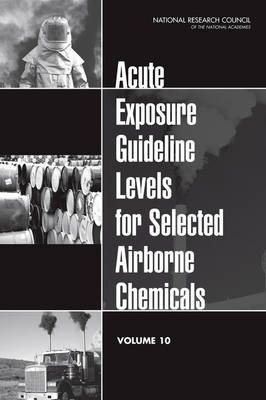
Acute Exposure Guideline Levels for Selected Airborne Chemicals
Volume 10
Seiten
2011
National Academies Press (Verlag)
978-0-309-21987-7 (ISBN)
National Academies Press (Verlag)
978-0-309-21987-7 (ISBN)
Extremely hazardous substances (EHSs)² can be released accidentally as a result of chemical spills, industrial explosions, fires, or accidents involving railroad cars and trucks transporting EHSs. Workers and residents in communities surrounding industrial facilities where EHSs are manufactured, used, or stored and in communities along the nation's railways and highways are potentially at risk of being exposed to airborne EHSs during accidental releases or intentional releases by terrorists. Pursuant to the Superfund Amendments and Reauthorization Act of 1986, the U.S. Environmental Protection Agency (EPA) has identified approximately 400 EHSs on the basis of acute lethality data in rodents.
As part of its efforts to develop acute exposure guideline levels for EHSs, EPA and the Agency for Toxic Substances and Disease Registry (ATSDR) in 1991 requested that the National Research Council (NRC) develop guidelines for establishing such levels. In response to that request, the NRC published Guidelines for Developing Community Emergency Exposure Levels for Hazardous Substances in 1993. Subsequently, Standard Operating Procedures for Developing Acute Exposure Guideline Levels for Hazardous Substances was published in 2001, providing updated procedures, methodologies, and other guidelines used by the National Advisory Committee (NAC) on Acute Exposure Guideline Levels for Hazardous Substances and the Committee on Acute Exposure Guideline Levels (AEGLs) in developing the AEGL values. In 1998, EPA and DOD requested that the NRC independently review the AEGLs developed by NAC. In response to that request, the NRC organized within its Committee on Toxicology (COT) the Committee on Acute Exposure Guideline Levels, which prepared this report.
Acute Exposure Guideline Levels for Selected Airborne Chemicals is the tenth volume of the series and documents for N,N-dimethylformamide, jet propellant fuels 5 and 8, methyl ethyl ketone, perchloromethyl mercaptan, phosphorus oxychloride, phosphorus trichloride, and sulfuryl chloride.
Table of Contents
Front Matter
Acute Exposure Guideline Levels for Selected Airborne Chemicals--Volume 10
National Research Council Committee Review of Acute Exposure Guideline Levels of Selected Airborne Chemicals
Roster of the National Advisory Committee for Acute Exposure Guideline Levels for Hazardous Substances
Appendixes
1 N,N-Dimethylformamide
2 Jet Propellant Fuels 5 and 8
3 Methyl Ethyl Ketone
4 Perchloromethyl Mercaptan
5 Phosphorus Oxychloride
6 Phosphorus Trichloride
7 Sulfuryl Chloride
As part of its efforts to develop acute exposure guideline levels for EHSs, EPA and the Agency for Toxic Substances and Disease Registry (ATSDR) in 1991 requested that the National Research Council (NRC) develop guidelines for establishing such levels. In response to that request, the NRC published Guidelines for Developing Community Emergency Exposure Levels for Hazardous Substances in 1993. Subsequently, Standard Operating Procedures for Developing Acute Exposure Guideline Levels for Hazardous Substances was published in 2001, providing updated procedures, methodologies, and other guidelines used by the National Advisory Committee (NAC) on Acute Exposure Guideline Levels for Hazardous Substances and the Committee on Acute Exposure Guideline Levels (AEGLs) in developing the AEGL values. In 1998, EPA and DOD requested that the NRC independently review the AEGLs developed by NAC. In response to that request, the NRC organized within its Committee on Toxicology (COT) the Committee on Acute Exposure Guideline Levels, which prepared this report.
Acute Exposure Guideline Levels for Selected Airborne Chemicals is the tenth volume of the series and documents for N,N-dimethylformamide, jet propellant fuels 5 and 8, methyl ethyl ketone, perchloromethyl mercaptan, phosphorus oxychloride, phosphorus trichloride, and sulfuryl chloride.
Table of Contents
Front Matter
Acute Exposure Guideline Levels for Selected Airborne Chemicals--Volume 10
National Research Council Committee Review of Acute Exposure Guideline Levels of Selected Airborne Chemicals
Roster of the National Advisory Committee for Acute Exposure Guideline Levels for Hazardous Substances
Appendixes
1 N,N-Dimethylformamide
2 Jet Propellant Fuels 5 and 8
3 Methyl Ethyl Ketone
4 Perchloromethyl Mercaptan
5 Phosphorus Oxychloride
6 Phosphorus Trichloride
7 Sulfuryl Chloride
1 Front Matter; 2 Acute Exposure Guideline Levels for Selected Airborne Chemicals--Volume 10; 3 National Research Council Committee Review of Acute Exposure Guideline Levels of Selected Airborne Chemicals; 4 Roster of the National Advisory Committee for Acute Exposure Guideline Levels for Hazardous Substances; 5 Appendixes; 6 1 N,N-Dimethylformamide; 7 2 Jet Propellant Fuels 5 and 8; 8 3 Methyl Ethyl Ketone; 9 4 Perchloromethyl Mercaptan; 10 5 Phosphorus Oxychloride; 11 6 Phosphorus Trichloride; 12 7 Sulfuryl Chloride
| Verlagsort | Washington |
|---|---|
| Sprache | englisch |
| Maße | 152 x 229 mm |
| Themenwelt | Studium ► 2. Studienabschnitt (Klinik) ► Pharmakologie / Toxikologie |
| Naturwissenschaften ► Biologie ► Ökologie / Naturschutz | |
| Naturwissenschaften ► Geowissenschaften ► Meteorologie / Klimatologie | |
| ISBN-10 | 0-309-21987-6 / 0309219876 |
| ISBN-13 | 978-0-309-21987-7 / 9780309219877 |
| Zustand | Neuware |
| Haben Sie eine Frage zum Produkt? |
Mehr entdecken
aus dem Bereich
aus dem Bereich
Buch | Hardcover (2024)
Thomas Karow (Verlag)
57,80 €
Buch | Hardcover (2022)
Urban & Fischer in Elsevier (Verlag)
99,00 €


